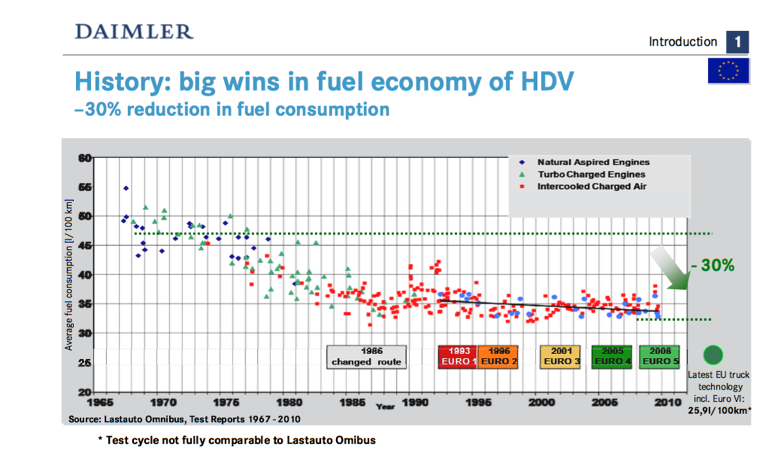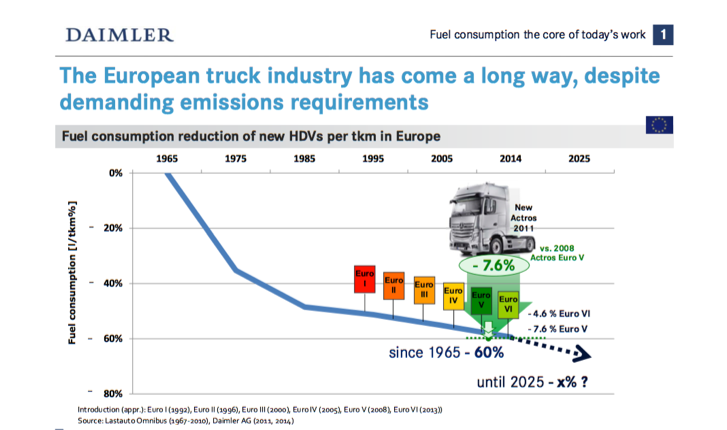Overview of the heavy-duty vehicle market and CO2 emissions in the European Union
Blog
Shell game? Debating real-world fuel consumption trends for heavy-duty vehicles in Europe
The European Commission now seems set on proposing new standards to limit CO2 emissions and improve efficiency from heavy duty vehicles. On March 13, Commissioner Arias Cañete spoke to the EU Parliament’s Environmental Committee and said there’s an “intention to propose emission standards next year.” This is welcome news to us at the ICCT. We have consistently argued for the economic and environmental benefits of well-designed vehicle efficiency standards (see, for example, here and here). And we have pointed out that in the absence of standards the average fuel-efficiency of heavy trucks and buses in Europe has remained roughly unchanged for more than a decade, even as average fuel consumption per kilometer in light-duty vehicles—which are subject to an efficiency regulation—has fallen steadily.
Not everyone is so pleased with the news coming out of Brussels, however, and some manufacturers have tried to persuade EU policymakers to hold the line that standards are unnecessary by saying that we’re just wrong about that last point: truck efficiency really is improving significantly on its own. But to support that claim they’re comparing one new high-performing truck to one old low-performing truck, while we have been saying that on average European trucks aren’t getting significantly more efficient. This is a shell game, and if we want to see real improvements in real-world fuel efficiency from European trucks and buses, we need to keep a close eye on the shell with the pea under it. If manufacturers can use that sort of sleight of hand to give policymakers in Europe the idea that the average new truck is improving significantly year to year then those policymakers will have no reason to impose efficiency regulations on the sector.
So let’s review.
In December 2015 we published a paper that discussed some data from Last Auto Omnibus, a German magazine that regularly reports on testing of EU HDVs. The data indicated that the average fuel consumption of tractor-trailers in the EU had not changed much in over a decade. Here’s the chart that we used:
and here’s the accompanying text from the paper discussing it:
The data presented in Figure 6 were obtained from Lastauto Omnibus, a German trucking magazine. The magazine performs extensive real-world fuel consumption testing on a select number of HDVs over a set of different duty cycles each year. For the purposes of our analysis, we looked at the annual average results from tractor-trailer testing on the “overall/average” cycle (the error bars in the figure represent the minimum and maximum fuel consumption values that were obtained each year). The overall/average cycle represents a duty cycle weighting consistent with typical usage of tractor-trailers for long haul operations. Each annual data point represents the average result of between five and ten tractor-trailers. A total of 98 tractor-trailers were tested from 2002 to 2014. As can be seen in the figure, the data indicates that the fuel consumption of tractor-trailers in the EU has not changed significantly over the past 13 years (note that tailpipe emissions were significantly reduced over that same time frame, which has made simultaneous efficiency improvements more challenging3).
(For the sake of thoroughness, here’s the text of the footnote 3 at the end of that paragraph: “For a more detailed discussion of how various criteria emission control approaches for HDVs affect fuel efficiency and vice versa, please see Section 3.2 in the following ICCT reference: http://www.theicct.org/sites/default/files/publications/ICCT_ChinaTechPathways_oct11.pdf”)
To clarify the situation further, here’s an update to our original figure, again using Lastauto Omnibus testing data, showing the trends for different manufacturers. This chart only includes tractor-trailers with engines in the 300kW to 400kW power range, which represents approximately 85%–90% of new tractor-trailer sales in Europe.
Clearly there’s little improvement to be seen in the Lastauto Omnibus data in average fuel consumption for these vehicles from 2002 to 2016.
Of course, graphically representing data can be more complicated than that example—a fact illustrated, as it happens, by two charts, shown below, built four years apart from Lastauto Omnibus data, not by us but by Daimler. The first, presented at a conference in November 2011, shows a 30% reduction in average EU tractor-trailer real-world fuel consumption between 1965 and 2010. (Note, incidentally, that the data between 2002 and 2010 in this chart aligns almost perfectly with our chart, because the majority of the reductions happened in the 70s and 80s.)
The second, presented at a conference in October 2015, shows a 60% reduction in average HDV real-world fuel consumption between 1965 and 2014—using the same data source, LastAuto Omnibus, for 1965–2010 and Daimler’s own data for 2010–2014.
How can one chart show a 30% reduction (average improvement of less than 1% per year) and the other show a 60% reduction (average improvement of almost 2% per year) if both use the same data set? Not because those last four years of data make such a difference. My best guess is that the first chart compared average values from 1965 against average values from 2010, and the second presented the highest fuel consumption values from 1965 against the lowest fuel consumption values from 2014.
As I say, that’s a guess—but it’s an educated guess. There’s precedent to support it. A 2016 testing project conducted by Lastauto Omnibus pitted a single Euro II tractor-trailer from 1996 against a single Euro VI tractor-trailer 2016, and concluded that the comparison showed that “Modern heavy-duty vehicles of the exhaust gas standard Euro 6 consume 22 percent less diesel than comparable Euro 2 models 20 years ago”. But to reach a general conclusion about Euro 6 trucks as a group, you’d really want to know the average fuel consumption, not simply compare two vehicles. Note that neither the 1996 truck or the 2016 truck was representative of the average market sales in those years. The 1996 vehicle was the most powerful on the market at the time, about 20% more powerful than the market average. The 2016 truck was equipped with optional efficiency technology such as Daimler’s most aerodynamic cab and predictive cruise control (predictive cruise control currently has around 20% market penetration in EU tractor-trailers). The dice were loaded.
A new study published by Lastauto Omnibus compares a 2002 Euro III DAF XF95.430 truck to a 2017 Euro VI DAF XF440 model. The fuel consumption results achieved were 41.9 l/100km for the 2002 truck and 35.6 l/100km for the 2017 truck—a nice 15% reduction in fuel consumption. But Lastauto had tested a 2002 Euro III DAF XF95.430 in 2003, and that time the results were 34.6 l/100km, a far cry from 41.9 l/100km. Based on that result, the difference between the 2002 and 2017 trucks would have been a one-liter per kilometer increase in fuel consumption—that is, essentially no change at all in fuel efficiency over fifteen years, and if anything a change in the wrong direction.
From the information that’s available it’s not possible to say what explains the different fuel-consumption values for identical 2002 DAF trucks; perhaps it’s a result of testing a 15-year-old used vehicle against a new vehicle, rather than a performance improvement. The real point is that in any case, single truck-to-truck comparisons result in limited data points and therefore limited conclusions. These comparisons present data that is not in line with the much larger amount of data that Lastauto has published over the years, which is what we’ve based our arguments on.
ICCT does not fail to give industry credit where credit is due; we know very well that new efficiency technologies have been developed and commercialized for trucks in Europe. But these technologies are only being deployed on a small fraction of new trucks, and therefore not having the fleetwide impact that Lastauto Omnibus and other similar testing projects hope to portray. What ICCT wants—for the benefit of the planet and of the economy—is these technologies to be taken up as quickly as possible by the bulk of the fleet in order to maximize the CO2 reduction benefit of these innovations. And we are hoping the EU’s upcoming heavy duty CO2 standard will help bring that about.




